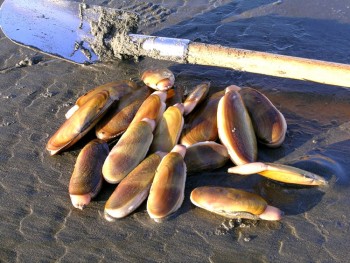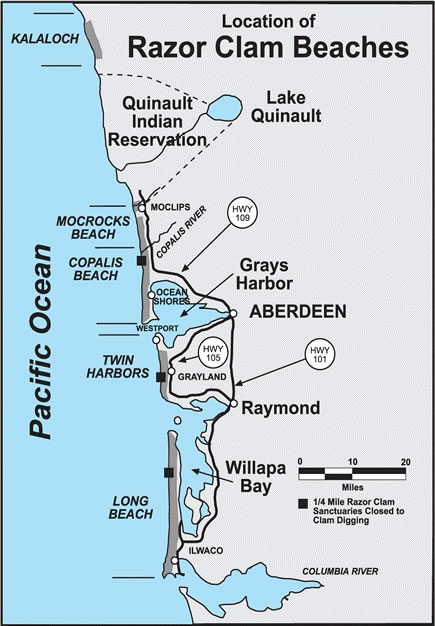Easter weekend clamming
March 20, 2013
Contact: Dan Ayres, (360) 249-1209
OLYMPIA – State shellfish managers have approved a four-day razor clam dig starting March 28 and scheduled tentative dates for additional openings in April.
The Washington Department of Fish and Wildlife (WDFW) approved the late-March dig after marine toxin test showed the clams are safe to eat.
Twin Harbors beach will be open for morning razor clam digging March 28-31.
Long Beach, Copalis and Mocrocks will be open to digging March 29-30.
No digging will be allowed at any beach after noon. The schedule, along with morning low tides, is:
- March 28, Thurs., 7:57 a.m., -0.3 ft., Twin Harbors
- March 29, Fri., 8:40 a.m., -0.6 ft., Twin Harbors, Long Beach, Copalis, Mocrocks
- March 30, Sat., 9:26 a.m., -0.7 ft., Twin Harbors, Long Beach, Copalis, Mocrocks
- March. 31, Sun., 10:16 a.m., -0.6 ft., Twin Harbors
By law, clam diggers are limited to 15 razor clams per day, and are required to keep the first 15 clams they dig. Each digger’s clams must be kept in a separate container.
All diggers age 15 or older must have an applicable 2012-13 fishing license to harvest razor clams on any beach. Licenses, ranging from a three-day razor clam license to an annual combination fishing license, are available on WDFW’s website at https://fishhunt.dfw.wa.gov and from license vendors around the state.
Meanwhile, WDFW has tentatively scheduled two morning digs in April, subject to favorable marine toxin tests. Final word on these digs will be posted on WDFW’s website at http://wdfw.wa.gov/fishing/shellfish/razorclams/current.html.
Dan Ayres, WDFW coastal shellfish manager, reminds diggers they will need to purchase a 2013-14 license to participate in the April openings, since current fishing licenses expire at midnight March 31. Licenses are available online (https://fishhunt.dfw.wa.gov/), by phone (1-866-320-9933) and from license dealers around the state.
Tentative opening dates in April, along with morning low tides, are:
- April 9, Tues., 6:39 a.m., 0.0 ft., Twin Harbors
- April 10, Wed., 7:19 a.m., -0.3 ft., Twin Harbors
- April 11, Thurs., 7:57 a.m., -0.4 ft., Twin Harbors
- April 12, Fri., 8:34 a.m., -0.4 ft., Twin Harbors, Long Beach, Copalis and Mocrocks
- April 13, Sat., 9:11 a.m., -0.2, ft., Twin Harbors, Long Beach, Copalis and Mocrocks
- April 14, Sun., 9:49 a.m., +0.1, ft., Twin Harbors, Long Beach, Copalis and Mocrocks
- April 24, Wed., 6:10 a.m., -0.3 ft., Twin Harbors
- April 25, Thurs., 6:54 a.m., -1.0 ft., Twin Harbors
- April 26, Fri., 7:38 a.m., -1.5 ft., Twin Harbors, Long Beach, Copalis and Mocrocks
- April 27, Sat., 8:24 a.m., -1.7 ft., Twin Harbors, Long Beach, Copalis and Mocrocks
- April 28, Sun., 9:11 a.m., -1.7 ft., Twin Harbors, Long Beach, Copalis and Mocrocks
- April 29, Mon., 10:01 a.m., -1.5 ft., Twin Harbors, Long Beach and Mocrocks
- April 30, Tues., 10:55 a.m., -1.0 ft., Twin Harbors
3 Ways to Catch Razor Clams
From Do it yourself
Razor clams are coastal shellfish, known for their rarity and their meaty contents. Found in the sand of the intertidal coastal beaches, they can be harvested in several ways.
The best way to start is to get to the beach is early in the morning, so you can follow the tide out. First, look for a “clam show.” At the edge of the surf line, there will be small dimples or holes in the wet sand as the water ebbs. It’s where the clam has stuck its neck out and tried to dig to go back to the sea. As soon as you see the telltale hole, start quickly with one of these methods:
Tools you will need gloves (razor clams are so named because of the sharp edges of their shells), ice chest, clam gun or tube (for1st way), clam shovel or other sharp curved, narrow bladed shovel (for 2nd way) and table salt (for 3rd way). Although, the tools will majorly depend on how you are catching clams.
Ways to Catch Razor Clams:
1. With a Tube or “Clam Gun”
The tube, or “clam gun,” you need for razor clams is about 2-3 feet long and 4 inches in diameter, with a ½ inch hole at the top. Stainless steel or metal will work best for digging in wet sand. The best idea is to just go to a fishing supply store and get a clam gun, but if you have something similar it could work just as well. A clam gun has a T-shaped top so you don’t have to try and cover it with your fingers while digging.
When you spot a clam show, place the tube around it, with the hole in the center and work the tube down into the sand at least 2 feet. Then cover the hole at the top and remove the tube. Empty the tube onto the beach and take the clam or clams out and put it in your ice chest. Clam guns can be difficult to use on rocky or pebble-filled beaches.
2. Dig With a Clam Shovel
Once you locate the holes in the sand, dig quickly with a clam shovel. Go straight down about 3-6 inches from the center of the clam show. Place the back of the shovel facing the hole and begin removing sand. Don’t curve it toward the center of the hole because you risk cutting the clam off at the neck or breaking the shell. Keep scooping straight down until you expose the clam. Then reach in and carefully grab it by the neck or shell and place it in your ice chest.
3. Salt Them Out
Razor clams are extremely sensitive to salinity. One way to reduce your effort and have the clams come to you is to use table salt. As soon as you see the show, when it is open widest, pour salt into the hole. The clam should emerge in order to escape the salt and then just catch it and place it in your ice chest.
Be sure to check fishing rules and seasons with the Department of Fish and Wildlife (1-866-880-5431). There’s a limit on how many clams you can harvest at one time. So be very careful when digging, especially with the clam shovel. The clams are fairly delicate and break easily. Clams with broken shells will die, but they will also count for your total, so don’t discount the broken ones. They can still be eaten, just harder to clean.


